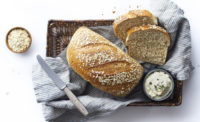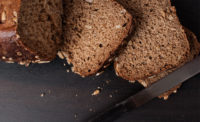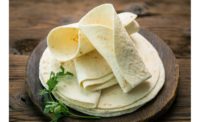Leavening ingredients and leavening aides are important ingredients that help consistently create the textural qualities of various baked goods. And like every ingredient segment within bakery, leavening agents are subject to ongoing shopper trends.
“The main trends impacting chemical leavening are clean label and nutritional concerns,” says Troy Boutte, Ph.D., vice president innovation, AB Mauri North America, St. Louis. “Leavening agents for clean-label baked goods go back to what is available in your kitchen which is sodium bicarbonate and tartaric acid (cream of tartar). Nutritional concerns can also be a factor in the choice of leavener and in some cases these concerns are interconnected with clean label concerns. People with certain health concerns may prefer to use leaveners with no sodium, phosphates, or aluminum. Leavening agents can be formulated to meet these requirements. Each of these specialized leavening agents will have slightly different functions, flavors and pricing.”
A diverse set of leavening ingredient solutions helps bakers meet far-ranging market demands. AB Mauri offers options to customers that may be looking for leaveners that are both clean label and also address a nutritional need. The company produces baking powders that do not contain aluminum-based leavening agents. They also produce several reduced sodium leavening agents geared toward a variety of different baked goods.
Bakers continually seek to build improvements into their products. With years of baking ingredient experience, Bartek Ingredients, Stoney Creek, Ontario, understands the need to provide new ingredients that simplify the baking process, enhance the consumer eating experience, can target ingredient replacement, and simplify the label. The company has recently launched two new, unique proprietary ingredient systems: Upscale and Uphold.
“Both Uphold and Upscale are specialty ingredient systems that take advantage of the unique functionalities of fumaric acid and malic acid to optimize the complete bread formula, including the main leavening agent (namely yeast), to improve the finished product quality and shelf life as well as the economics of the baking operation,” explains Mohammad Emami, senior product marketing manager, Bartek Ingredients. He notes these ingredients also enhance product softness and volume, and improve cell structure in both traditional breads, such as pan breads and rolls, and artisan breads, such as ciabatta and baguettes.
Alejandro J. Perez-Gonzalez, lead technical advisor, bakery innovation, Bartek Ingredients, digs into some of the specifics:
-
Upscale Artisan Bread Technology is a patent-pending technology designed to increase the cell structure, enhance porosity, and deliver high-quality artisan breads produced at industrial scale. Upscale works best in artisan-style products where the unique porous character is desired.
-
Uphold Bread Preservation Technology designed to extend shelf life and boost efficacy of the preservative systems used, while also helping improve the volume of the breads. The Uphold line is geared primarily to any yeast raised bakery product like breads, rolls, and rich doughs, although it can function in specific chemically leavened applications, namely flour tortillas.
Due to the unique features of Upscale to improve volume and porosity in bread, there is the potential to reduce one or more of the ingredients (i.e., yeast, vital wheat gluten, and/or high protein flours) in a formula, if supply becomes an issue. This will depend on the specifics of the formula, process, and desired bread characteristics.
Bellarise, Pasadena, CA, has continued to build on the roll-out of its Bellarise Supreme Instant Dry Yeast product. This new product was designed for bakers searching for ways to speed up production, lower costs, and get the highest-quality breads at every bake, note Cam Suarez-Bitar, director of marketing and public relations. “Bellarise Supreme Instant Dry Yeast cuts proof times by up to 15 percent while yielding an increase of up to 30 percent in gassing power when compared to standard red instant dry yeast. In various applications, industrial bakeries can use less Bellarise Supreme Instant Dry Yeast than red instant dry yeast in the same formula and achieve similar results at a lower cost,” he says.
The company also recently improved its all-new Bellarise Organic Sugar Replacer. This new and improved ingredient, gives bakers more control over the texture and overall quality of organic and conventional breads, says Suarez-Bitar. “It also serves as an excellent yeast food.”
Addressing the supply chain
In this time of periodic ingredient and supply-chain challenges, it is important to optimize use of ingredients. “Our history and expertise helping industrial bakeries move from other forms of yeast to instant dry yeast has been essential during the supply-chain crisis,” says Suarez-Bitar. “We have shown R&D teams at large bakeries how to find efficiencies while either maintaining or improving overall bread quality by converting to Bellarise Instant Dry Yeast from other forms of yeast, such as cream yeast and fresh yeast.”
Suarez-Bitar explains the nuances between the different formats of yeast:
-
Instant dry yeast:
-
Consists mostly of yeast (96 percent solids, 2–4 percent water)
-
Comes in two variants: Red (for low-sugar doughs which contain 6 percent or less sugar) and Gold (for sweeter doughs containing 6 percent or more sugar)
-
It is ready to use right out of the package
-
Has a two-year shelf life
-
Can be stored at room temperature
-
-
Cream yeast and block yeast:
-
Contains mostly water (18–20 percent yeast solids with 80–82 percent water, and around 33 percent yeast solids with 67 percent water, respectively)
-
Both forms require refrigeration and cold storage
-
Shorter shelf life versus instant dry yeast
-
The company has also taken several measures to ensure source of supply of its products. Bellarise and its parent company Pak Group are vertically integrated, which helps provide more control over production and logistics. “From the outset of the pandemic, we have responded to home bakers’ increased demand for yeast by providing some of the nation’s largest retailers with Bellarise Instant Dry Yeast, which enabled them to keep their shelves stocked as demand spiked. The fact that we have so much more control over yeast production and packaging helps us be nimble and responsive, especially when market dynamics are unexpectedly disrupted by events like the pandemic,” explains Suarez-Bitar.
AB Mauri is approaching supply chain challenges by continuing to approve additional sources for raw materials and ingredient suppliers to help mitigate risk and working with their Innovation, New Product Development, and Quality teams to identify substitutions if comparable sources are not available. One example is moving to higher concentration levels on certain items to reduce the overall usage. The company is also building in extended lead times and placing orders for raw materials much farther in advance, so their suppliers have time to plan and to be able to better accommodate their needs.




